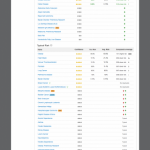2010 4
23andMe and my Genetic Ancestry
Published by MartinVarsavsky.net in Internet & Technology with No Comments
Last month I posted my genetic disease risk profile according to 23andMe. For those of you who don’t know this company, 23andMe is a genetic testing service that provides information and tools to understand your DNA. How does it work? Well, it’s really easy. You order a kit from their online store, spit into the tube that comes with the kit, send it back and in 6 to 8 weeks you can log into your account and start investigating your genome. I’m an investor in 23andMe and I was very curious to try out the service. The results to my genetic disease risk profile were quite interesting, but what I really find fascinating is that from just a few drops of saliva I can learn lots about my ancestry.
23andMe offers information on both sides of the family. I learnt that from my mother’s side, my haplogroup is H7. The haplogroup H “originated in the Near East and then expanded after the peak of the Ice Age into Europe, where it is the most prevalent haplogroup today. It is present in about half of the Scandinavian population and is also common along the continent’s Atlantic coast”. The haplogroup H is over 40,000 years old, and it’s present mostly in scandinavians and basques. Below you can see a map indicating the presence of this group:

From my father’s side the information is completely different, and quite interesting at that. My paternal haplogroup is E1b1b1c1, which is a subgroup of haplogroup E. This haplogroup arose in the eastern part of Africa about 30,000 to 40,000 years ago. It’s pretty common in Africa, present in Arabs and Berbers, Senegalese and Bantu-speaking groups in South Africa and Kenya in levels of almost 75%. E1b1b1c1 comes from E1b1b1c, and it’s the most popular group stemming from it. It originated at the end of the Ice Age, around 15,000 years ago, and now it’s common in eastern Africa, the Near East and Mediterranean European populations. Below, my paternal ancestry map:

But the most interesting thing about my parental genetics is that, according to 23andMe, you can be genetically jewish. If someone had told me that before, I’d have though that this person was very racist. However, now I see that it is actually possible. My paternal haplogroup is present in Ethiopians, Jordanians, Ashkenazi and Sephardic Jews. E1b1b1c1 averages 10% among both Ashkenazi from eastern Europe and Sephardic Jews from Iberia. It’s also present in Ethiopian Jews, Yemenite Jews and Libyan Jews. This means that this specific haplogroup was present in the Jews that left the Levant and spread through the Old World around 2,000 years ago, which means that it is possible to determine if a person is Jew or has jewish ancestry based on their DNA. Who knew?
23andMe also offers a map of “global similarity”, so you can compare your genetic information to those around the world and see in which parts of the world there are people with similar genetic information to yours. Mine says I’m closest to Southern and Northern Europeans, then Near Eastenders and Central Asians. I also resemble Northern Africans, Siberians, North Americans, South Americans, Oceanians and Eastern Asians.

Follow Martin Varsavsky on Twitter: twitter.com/martinvars
Related Posts
No Comments
Pensamientos Neoliberales on November 9, 2010 ·
Interesting, isn’t it?
I did my Y chromosome DNA test as a collaboration to” the genographic project” https://genographic.nationalgeographic.com/genographic/index.html
My haplogroup is J2….
Jimena on November 11, 2010 ·
Martin,
Super interesante! Le voy a pasar el link a mi hermana que estudia Biologia Molecular en Cornell.
Ahora lo importante es ver si uno se queda con la informacion como algo anecdotico o lo usa para prevencion.
Next steps? En los items de mayor riesgo… en que medida vale la pena hacer algo al respecto? El tema esta en dar prioridad a la medicina homeopatica y
naturista vs medicamentos de laboratorios. De todas formas ayudara una vida mas sana: alimentacion, meditacion, ejercicio.
Muchas veces uno tiene informacion pero lo que le da valor es llevarlo a la practica.
Mi aporte de los ultimos meses ha sido: No mas gaseosas. Raw sugar. Elimine los edulcorantes artificiales. Mas paz interior. : )
Nos vemos.
jime
Pensamientos Neoliberales on November 11, 2010 ·
Actually, after reading your post and the”genetically jew” comment, I went back to see my results and it happens that the J2 haplogroup is practically the “jew”haplogroup, present in over 30% of Ashkenazi and Sephardic. I’ve heard my dad talking about the “conversion” at some point for my ancestors (my family is catholic), but I guess this is further evidence….
Hernán on November 12, 2010 ·
Martin, this is pretty silly. You most surely know that the genetic makeup of a person does not represent a strong indication to the quality of live of that person. So my advice is to not waste you money in the company’s services, and use that money to buy yourself a good litre of orange juice. That’ll help you live happier and longer…
Martin Varsavsky on November 15, 2010 ·
Hernán, there are a lot of things that can be done to prevent early death as a result of poor genes. Colonoscopies are good example, an exam which is both a diagnose and surgery. If you have a genetic predisposition to colon cancer, you start earlier in life with a colonoscopy (recommended after 50) and more frequently. And that alone can make the difference between being alive, and being dead.
A.Squecco on November 20, 2010 ·
Martin,you can try to get more info from your YDNA results participating to this project:
http://www.facebook.com/pages/YDNA-SNPs-Comparison-Project/166307390055000
http://daver.info/ysub
Best regards,
Adriano
Leave a Comment
You must be logged in to post a comment.






Luis on November 4, 2010 ·
Realmente muy interesante.
Tenía mucha curiosidad de como era presentada esta información por 23andMe, muchas gracias por compartirlo.
Abrazo
Luis